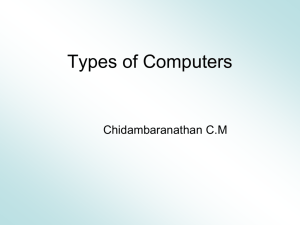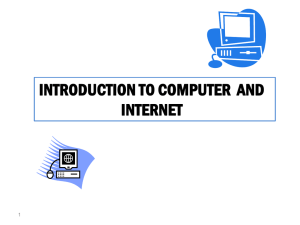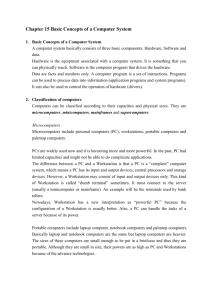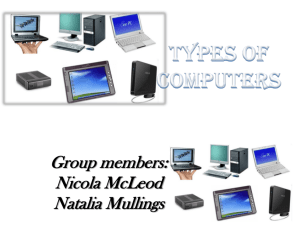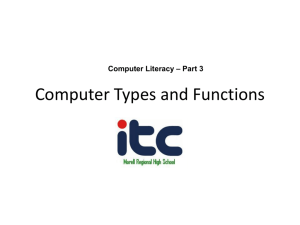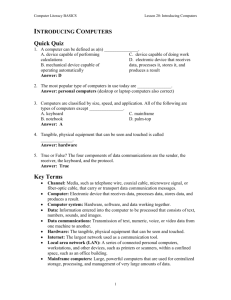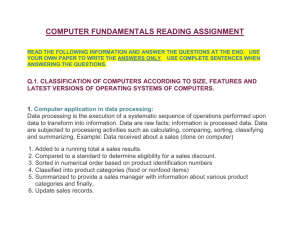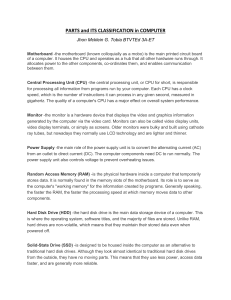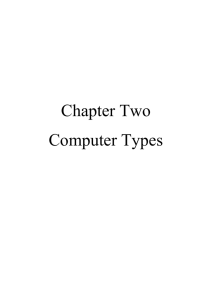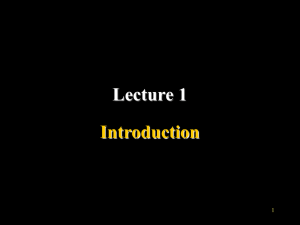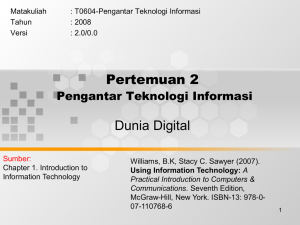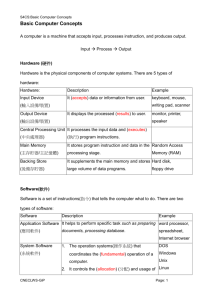Computers and Information Systems
advertisement
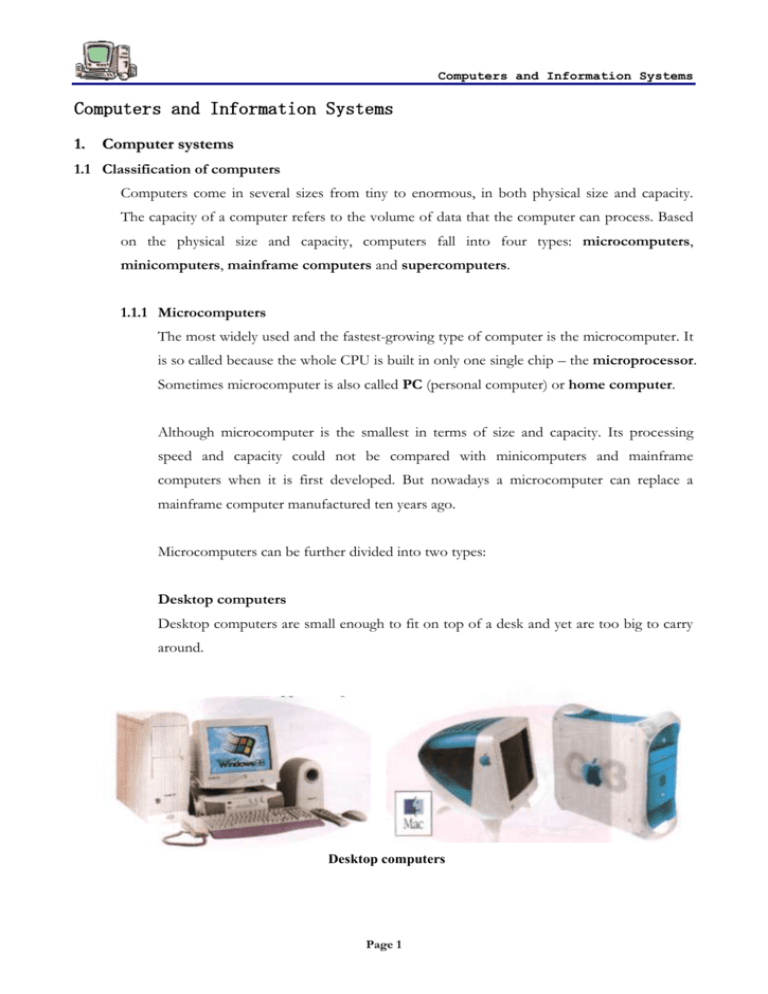
Computers and Information Systems Computers and Information Systems 1. Computer systems 1.1 Classification of computers Computers come in several sizes from tiny to enormous, in both physical size and capacity. The capacity of a computer refers to the volume of data that the computer can process. Based on the physical size and capacity, computers fall into four types: microcomputers, minicomputers, mainframe computers and supercomputers. 1.1.1 Microcomputers The most widely used and the fastest-growing type of computer is the microcomputer. It is so called because the whole CPU is built in only one single chip – the microprocessor. Sometimes microcomputer is also called PC (personal computer) or home computer. Although microcomputer is the smallest in terms of size and capacity. Its processing speed and capacity could not be compared with minicomputers and mainframe computers when it is first developed. But nowadays a microcomputer can replace a mainframe computer manufactured ten years ago. Microcomputers can be further divided into two types: Desktop computers Desktop computers are small enough to fit on top of a desk and yet are too big to carry around. Desktop computers Page 1 Computers and Information Systems Portable computers Portable computers are microcomputers that are small and light enough to move easily from one place to another. There are several types of portable computers: notebook computers, sub-notebook computers, handheld PCs. Notebook computer Sub-notebook computers Handheld PC Can you tell me the names of some PC manufacturers? _____________________________________________________________________ _____________________________________________________________________ 1.1.2 Minicomputers Minicomputers are larger in size and more powerful than microcomputers. They are designed for multi-users and usually used by medium-size companies or departments of large companies to do research or to monitor a particular manufacturing process. Usually a minicomputer has a powerful CPU and several terminals which can access the CPU for processing. Minicomputer Page 2 Computers and Information Systems 1.1.3 Mainframe computers Mainframe computers are large computers occupying specially wired, air-conditioned rooms. They are composed of a number of separate units and usually act as a server for a network. Mainframe computers are typically used by large organized, business, banks, universities and government agencies, to handle millions of transactions. Mainframe computer In early days of computing, only mainframe computers were available. Minicomputers were developed since early 1960's and microcomputers were developed in mid 1970's. 1.1.4 Supercomputers Supercomputers are the most powerful and expensive computers. They can process billions of instructions per second. They are usually used in scientific research, weather forecasting, space explorations, engineering design and military defense. Supercomputer Page 3 Computers and Information Systems 2. Computer network 2.1 The need for networking Networking is the process of connecting computers that permits the transfer of data and programs between them. Its tremendous benefits have been proved by the widely use of Internet. 2.2 Network types Local area network (LAN) A LAN is a collection of computers and peripherals located relatively close to each other and connected by cables. It is generally confined to a small area such as a building or an office. For example, the network inside the school is a LAN. File server Usually there is a central computer inside a LAN which is called a server. Each individual computer on the network can have access to the files on the server. The other computers on the network are always called workstations. Wide area network (WAN) Computers in different countries and cities around the world can be connected through wide area networks. A WAN is usually a collection of LANs. For example, a bank has hundreds of branches in different locations in a country. Each branch has its own LAN. All LANs are connected together to form a WAN, hence a banking system. Furthermore, a banking system can be connected to another banking system to form a larger network. Page 4 Computers and Information Systems Internet is the most famous and widely used WAN in the world. It connects thousands of networks around the world. Give some examples of networks you find in the daily life. __________________________________________________________________________ __________________________________________________________________________ __________________________________________________________________________ 2.3 Advantage of networking Communication With computer networks, people can talk to each other on computers, and send messages and document files to others through e-mail. Messages are sent immediately and no paper is needed. The message can be stored and duplicate copies can be sent to several destinations at the same time. Give some advantages of e-mail over traditional postal system. __________________________________________________________________________ __________________________________________________________________________ __________________________________________________________________________ __________________________________________________________________________ Page 5 Computers and Information Systems Sharing of hardware Hardware devices such as laser printers and plotters can be shared by networking. So cost and space can be saved and. Data Sharing of information Many organizations such as banks, supermarkets, airline companies need to share information. Networking makes it possible for them to access data kept in a database or even more than one database. For example, when a customer buys an airline ticket from a travel agency, the database in the server must be updated at once. Otherwise, there may be another customer buys the same ticket at later time. 3. Information processing 3.1 Information and data There are plenty of data around us in the daily life. For example, raw marks got in examination, prices listed in a supermarket, telephone numbers of schoolmates. Consider the following list of numbers: 31, 28, 31, 30, 31, 30, 31, 31, 30, 31, 30, 31 What does it tell us? Not a lot! They may be the temperatures of 12 consecutive days. the marks got by a student in twelve tests. the weights (in kg) of 12 girls. Page 6 Computers and Information Systems Unless we specify what they are, they would remain just numbers and contain little meaning. If we say that these numbers represent the weights of 12 girls in kilograms, we have changed our numbers into data. We can then add all the numbers together and divide the sum by 12. Then we get the average weight of the students, i.e. 30.3 kg. This new information about the weights of the students is produced as a result of data processing. So, we have the following definitions: Data are recorded facts or raw figures. Information contains interpreted data: data that have been processed into a form that is meaningful and useful to the user. Data processing is the transformation of data into information by means of a set of predefined rules. Data Data Processing Information More examples: Exam. raw marks Data Processing Readings from electric meters Data Processing Page 7 Ave. marks, positions Electric bills Computers and Information Systems 3.2 Concepts of data processing 3.2.1 EDP Manual data processing means the operations are mainly processed manually. We can find that some people still perform calculations by means of abacuses in some traditional shops. Electronic data processing (EDP) means that data are processed mainly by computers. This kind of processing is a trend in our society. Examples of EPD: Payroll system Point of sale system Give some more examples of manual data processing systems and EDP systems. _____________________________________________________________________ _____________________________________________________________________ _____________________________________________________________________ Page 8 Computers and Information Systems The following are operations usually involved in a data processing system (taking an examination result processing system as example): Calculation – find the total mark, average mark of each student Searching – find the average mark of a particular student from all records of a class Sorting – arrange the records of a class in descending order of average mark in order to find the positions in class of all students Deleting – delete the record of a left student Inserting – insert the record of a newly admitted student Updating –correct a wrongly entered mark Report generation – print examination report for each student Write down some examples of operations in a library system Calculation ______________________________________________________ _____________________________________________________________________ Searching ________________________________________________________ _____________________________________________________________________ Sorting __________________________________________________________ _____________________________________________________________________ Deleting _________________________________________________________ _____________________________________________________________________ Inserting _________________________________________________________ _____________________________________________________________________ Updating ________________________________________________________ _____________________________________________________________________ Reporting generation ______________________________________________ _____________________________________________________________________ Page 9 Computers and Information Systems 3.2.2 Data accuracy The accuracy of data is essential in a data processing system. Although the system is accurate and efficient. If the data inputting data is not correct, the output from the system will not be correct and accurate. Think of an examination result processing system. If the marks entered in the system are always incorrect. What will happen? A good student may be repeated instead of promoted! This concept is sometimes called garbage-in-garbage-out. Data processing system 3.3 Modes of operation Data processing systems can be divided into two kinds: Batch processing – All data are collected into a batch and then run as a group. There is a time delay between the collection of data and output of result. Examples: marking of exam. scripts, preparing electric bills Real time processing – Data are processed as soon as they are received. The system produces an immediate response. Examples: Easy Pay System, concert tickets booking system Which mode of operation should be used for a washing machine? Why? Page 10
